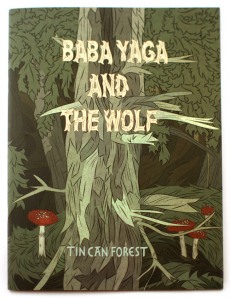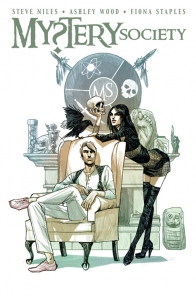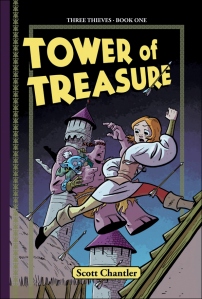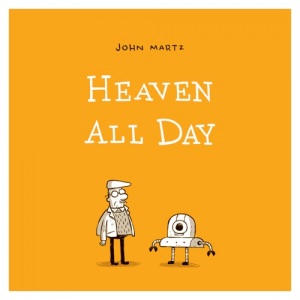Winners of the 2011 Joe Shuster Awards Announced!
This past weekend at the Calgary Comics & Entertainment Expo, the winners of the 7th annual Joe Schuster Awards were announced. Because I wasn’t able to attend, I almost forgot that the awards were announced at the event. I guess I must have blocked the whole thing out!
You can find the list of this year’s winners in the official press release, which is posted below. Congratulations to all of the winners and nominees!
Calgary, Alberta — June 18, 2021. From coast to coast, Canada is home to many of the comic book industry’s top talents, and the JOE SHUSTER AWARDS are a way of recognizing and celebrating their achievements. Since it was established in 2004, the Joe Shuster Award program is the national awards program for recognizing the outstanding achievements of Canadian comic book creators, publishers and retailers. The awards are named after pioneering Toronto-born artist Joe Shuster who, along with writer Jerry Siegel, created the iconic super-powered hero, Superman.
THE RESULTS ARE:
Outstanding Comic Book Artist / Dessinateur Exceptionnel de Bandes Dessinées
 FRANCIS MANAPUL — Adventure Comics #6, The Flash #1-6, Superman/Batman #75 (DC Comics)
FRANCIS MANAPUL — Adventure Comics #6, The Flash #1-6, Superman/Batman #75 (DC Comics)
In 2009, Francis Manapul adopted an ink-wash style that semi-renders his figures and backgrounds, and combined the new approach with his already solid skills as a comics penciler to add a depth and tonality to his environments that gives his work a unique quality. His work on the Flash in 2010 is both mature in its storytelling and some of the best use of his new technique so far.
Outstanding Comic Book Cartoonist / Créateur Exceptionnel de Bandes Dessinées
 TIN CAN FOREST (aka Pat Shewchuk and Marek Colek) — Baba Yaga and the Wolf (Koyama Press)
TIN CAN FOREST (aka Pat Shewchuk and Marek Colek) — Baba Yaga and the Wolf (Koyama Press)
Visually influenced by the dense forested landscape of British Columbia, Baba Yaga and the Wolf tells the story of Katerina and the journey she takes to the edge of the Underworld and its gatekeeper, Baba Yaga, in order to save her husband Ivan from a terrible fate.
The cartooning team known collectively as Tin Can Forest are Marek Colek and Pat Shewchuk, and in Baba Yaga they draw inspiration from early Russian animated films, Slavic mythology, and symbols and pictography associated with the many iterations of the Baba Yaga mythos, and have given new breath to an age-old cautionary tale of being careful to voice that which one most desires in a world where every leaf on every branch on every tree might be aware of such wants and the darkness that exists at their root
Baba Yaga and the Wolf is an outstanding book, a beautiful, envelope-pushing package – Tin Can Forest and Koyama Press have produced a work that definitely deserves wider attention.
Outstanding Comic Book Colourist /Coloriste Exceptionnel de Bandes Dessinées
 JULIE ROCHELEAU — La fille invisible (Glénat Québec)
JULIE ROCHELEAU — La fille invisible (Glénat Québec)
The jury was taken with Julie’s expressionistic use of colours for La Fille Invisible, and felt that they added so much to the overall atmosphere and tone of the book.
Outstanding Comic Book Cover Artist / Dessinateur Couvertures Exceptionnel de Bandes Dessinées
 FIONA STAPLES — Mystery Society #1-5 (IDW), DV8: Gods and Monsters #1-8 (DC/Wildstorm), Superman/Batman #79 (DC Comics), Acts of Violence: An Anthology of Crime Comics (New Reliable Press), Magus #1 (12 Gauge Comics)
FIONA STAPLES — Mystery Society #1-5 (IDW), DV8: Gods and Monsters #1-8 (DC/Wildstorm), Superman/Batman #79 (DC Comics), Acts of Violence: An Anthology of Crime Comics (New Reliable Press), Magus #1 (12 Gauge Comics)
The jury was particularly enamored with Fiona’s covers, feeling they stood out due to their excellent use of negative space. This allowed characters and imagery to stand out – resulting in bold, dynamic and eye-catching visual statements.
Outstanding Comic Book Publisher / Éditeur Exceptionnel de Bandes Dessinées
Koyama Press was founded in 2007. After a career in the film industry, a brain aneurism and a risky surgery had Annie reevaluate things. Annie decided that she didn’t want to return to film, but instead nurture and assist cartoonists to get their art out in front of the world. “Art, books and connecting people”, these are her passions.
Annie Koyama publishes undiscovered or unknown creators. Her very first project was an art book by Trio Magnus, a 3 person art collective in Toronto. Annie sold her car and used the money to publish their book, and sent them all to Japan to promote it. This was her very first project!
Over the past 2 years she has produced the first book, or very early works, by an ever growing number of young, up & coming creators, including: Michael DeForge, Dustin Harbin, Steve Wolfhard, Chris Eliopoulos, the Wowee Zonk collective, and many others, including Baba Yaga and the Wolf by Tin Can Forest, which was nominated for Outstanding Cartoonist.
Annie has had a huge and dramatic impact on the Toronto comic scene, one of the biggest comic scenes in the world.
She gives these young, struggling, up & coming stars of the next generation their first opportunities and they love her for that. All of the creators she works with gush about her.
She is doing the work that a publisher should: finding the next generation of creators, releasing unique, high-quality books in a variety of formats for a the entire spectrum of readers, from children’s books to colouring books to anthologies, zines, comics and art books.
Anne Koyama and Koyama Press, a wonderful woman and very deserving winner of our Outstanding Publisher award.
Outstanding Web Comics Creator /Créateur Exceptionnel de Bandes Dessinées Web
 EMILY CARROLL — His Face All Red, Dream Journals, The Death of José Arcadio, Out the Door, The Hare’s Bride
EMILY CARROLL — His Face All Red, Dream Journals, The Death of José Arcadio, Out the Door, The Hare’s Bride
Carroll is a young, fresh cartooning voice, her visuals are strong and appealing, and her choice of colour and her effective storytelling was enhanced by the medium itself. From the blood line that trickles down the screen to the astonished maid in the Death of Jose Arcadio to the beat by beat, point and click storytelling used to great dramatic effect in His Face All Red, Carroll effectively makes the reader a part of the action in a way that traditional paper and print storytelling just isn’t capable of doing.
Outstanding Comic Book Writer(s) / Écrivain(s) Exceptionnel de Bandes Dessinées
 ÉMILIE VILLENEUVE – La fille invisible (Glénat Québec)
ÉMILIE VILLENEUVE – La fille invisible (Glénat Québec)
In La Fille Invisible, Emilie Villeneuve tackles the topic of eating disorders in the story of Flavia, a 15 going on 16 year old girl who is both shy and curious, but lacks self-confidence and decides that she must remake herself in order to be accepted. In her new obsession, she begins to lose control of who she is begins purging: and in doing so she becomes the Invisible Girl of the book’s title. La Fille Invisible aspires to to warn readers of the very real problems that face young people, and address some of the issues that lead to the development of eating disorders. The jury was particularly impressed with the way in which Villeneuve chose to tell Flavia’s story – a unique mixture of traditional story-telling and a documentary style approach enhanced by her effective research on the subject.
Comics for Kids / Bandes Dessinées pour Enfants
This award recognizes the works which capture the attention and fascination of young readers, and help to create a passion for life-long reading. Works considered for this award are comic books and graphic novels by Canadian creators that are targeted at readers 14 and under. Nominees for this award are selected from the eligible creators lists by a team of educators led by Jennifer Haines, MA, B.Ed., who is also the proprietor of Guelph, Ontario’s The Dragon comic book shop.
 THREE THIEVES BOOK 1: TOWER OF TREASURE by Scott Chantler (Kids Can Press)
THREE THIEVES BOOK 1: TOWER OF TREASURE by Scott Chantler (Kids Can Press)
The winner was selected for several reasons: the art style is dynamic and instantly attracts the attention of young readers. It educates about human relationships, and has a strong female protagonist, in a story which is engaging for both boys and girls. Furthermore, the ending makes readers want more, which leads to more reading, the ultimate goal of any kids book.
The Gene Day Award for Self-Publishers / Le Prix Gene Day pour Éditeurs Direct de Bandes Dessinées
Named after the late Howard Eugene Day (1951-1982), this award honours Canadian comic book creators or creative teams who self-published their work during the previous calendar year, but did not have the books distributed by a third party distributor. The nominees were selected from over 50 individual publications submitted for review. The award winner receives a bursary of $500.
With Heaven All Day Martz continues to grow as a cartoonist. In this wordless story, Martz merges his draughtsman skills and animation sensibilities to produce a wonderful story filled with isolation, melancholy and, in the end, hope.
The Harry Kremer Award for Outstanding Comic Book Retailer /Le Prix de Harry Kremer pour Détaillant Exceptionnel de Bandes Dessinées
Named after the late Harry Kremer, original owner of Now & Then Books (in Kitchener, Ontario). Shops are recommended by the general public and a separate Retailer Award Committee reviews all materials received and select a short list of stores that has shown merit in a variety of categories such as: (1) Support of a wide variety of innovative material, (2) Overall appeal of the store and usage of space, (3) Knowledge, (4) Community activity, and (5) Adherence to standard ethical business practices.
Congratulations to all of the nominees and all of the eligible creators for another memorable year of great comics, both in print and online!
Canadian Comic Book Creator Hall of Fame / Temple de la renommée Créateur Canadien de Bandes Dessinées
Who is Chester Brown? A cartoonist? An artist? A writer? A political activist? A provocateur? A Canadian? Actually, he is all of these things. Most importantly he is an award-winning cartoonist, one who has always followed his own guiding star. Chester Brown has successfully worked in any number of different styles and genres. He is a master of surrealism – of the painfully honest, – the poignant art of autobiography, – and historical storytelling.
Chester Brown was born in Montreal on May 16, 1960, and grew up in the Montreal suburb of Chateauguay. (shat-oh-goo-eh). If there was one constant in the life of young Chester Brown, it was that he always knew that he wanted to go into: comics. From the day his mother gave him his first comic book, there was never any question of an alternative career for Chester Brown. It was comics, or nothing!
Following high school, Chester Brown enrolled in Dawson College’s prestigious commercial art program. He stayed for a single year, but while he was there he worked on fanzines put out by his comics-loving classmates, including one called “Weird Tales”. At “Weird Tales”, Chester started out as an artist, but found he was extensively rewriting the stories and dialogue he was given to work with. He decided early on that it would be more interesting to try writing his own material, rather than rewriting the work of others.
He tried his hand with the mainstream publishers – he went to New York twice, once when he was 17 and again when he was 19. Hoping to find work on the horror and mystery comics published by Marvel and DC, he received constructive feedback from Vinnie Colletta and later, from Jim Shooter. Shooter told him his people weren’t pretty enough for Marvel, and that was pretty much the end of his mainstream aspirations. He firmly set on the alternative comics’ path, and he had a flood of inspirations to draw from, including Dave Sim’s “Cerebus”,” the Hernandez Brothers’ “Love & Rockets”, and the comics of Art Spiegelman and Robert Crumb, the artists showcased in “Heavy Metal” like Moebius, and the later career work of Will Eisner, such as “A Contract with God”. Another profound influence was the work of classic comic-strip artist Harold Gray, the creator of “Little Orphan Annie”. Chester Brown sent his work to small, experimental publishers like Raw, Last Gasp, and Fantagraphics. After a year spent constantly drawing, he left Montreal for Toronto. He got a job at Galbraith Reproductions, where the job perks included the free use of the copying equipment.
In 1983 he launched his mini-comic series “Yummy Fur” (a title he chose because it didn’t actually mean anything but sounded provocative). He began selling Yummy Fur directly to Toronto bookstores and comics shops, and offered it through mail order, and he found an audience that was receptive to his work. In 1986 he met Vortex publisher Bill Marks and worked out an arrangement to publish a new Yummy Fur comic book series, and Chester used it as a vehicle for both his short strips and longer-form projects. Brown was also receiving invitations to contribute his work to various anthology books, which he did – such as Steven Bissette’s Taboo and the True North anthology. He was quickly solidifying his status as a premier voice in the small press comic scene of the 1980s. He also produced the giveaway comic that accompanied the release of director Ron Mann’s excellent documentary Comic Book Confidential.
Meanwhile the pages of Yummy Fur were filled with stories of all kinds of styles and genres. He dealt with religious subject matter by making an ambitious comic-strip adaptation the Gospel of Mark, and part of the Gospel of Matthew. He experimented with Surrealism and automatic writing, most famously in the “Ed the Happy Clown” series. There were the purely experimental works such as the daring but never-completed “Underwater”.
During this time he became close friends with fellow Canadian cartoonist Seth, and he gradually began to move away from his earlier, more experimental work. Talking with Seth made him realize that “the stories that make up our own lives are more interesting than the stories one usually encounters in comic books.” He worked with autobiographical subjects from his day-to-day life in stories like Helder, and its quasi-sequel, Showing Helder. He reached into his memories to tell the story of The Playboy, and I Never Liked You.
In 1989, Seth and Chester met and eventually befriended American cartoonist Joe Matt and the three cartoonists quickly became inseparable, known to all as “The Toronto Three”. This friendship also left its mark on Chester’s cartooning: as he and his friends began to make regular appearances in each other’s autobiographical comics, a practice that continues today.
In 1990, Chester Brown had found himself a new publisher — Drawn & Quarterly, the brainchild of Chris Oliveros. D+Q became the publisher of Yummy Fur with the 25th issue and also began to release collected editions of longer stories from previous issues, such as the Playboy and I Never Liked You.
After experimenting with autobiographical, religious, and surrealist stories, Brown took a step away from his roots to tackle the story of the famous Métis leader and revolutionary Louis Riel, first as a serial in Yummy Fur, and later collected as a 10-part mini-series and then a single edition graphic novel. It took Brown five years to research, and then cartoon. His years of effort would be rewarded: the “comic-strip biography” became a critical smash, and a runaway best seller. Louis Riel was admired for its thoughtful script, which perfectly meshed with its pristine clarity of line, strongly reflecting the influence of Harold Gray’s work. Seven years later, “Louis Riel” has been reprinted frequently, and remains a perennial favourite with critics and readers.
When not cartooning, Chester Brown has always been interested in politics, and is an anarchist-turned-libertarian by inclination — he is involved with the Libertarian Party of Canada, and has run as a party candidate in the last few federal elections.
And so we come to 2011, and he has released his newest, most provocative work yet: “Paying For It”, which made its debut less than two months ago at the Toronto Comic Arts Festival. Fearless as ever, Chester Brown has pulled the curtain back on the world’s oldest profession, and I don’t mean farming… Paying for It is a graphic memoir about his life as a John. He cloaks his tale in a clear, minimal visual style, adhering to a set number of panels per page. The result is a book that forces the reader to think – about the sex trade, about the nature of relationships, about the law, and about their own sense of morality.
Nearly thirty years after the first issue of Yummy Fur made its debut – Chester Brown is still exploding taboos and telling the stories no one else will in a clear, unsentimental, but beautiful way.
Controversial, and determined, he is an artist like no other, and a uniquely Canadian voice.
Biography by Debra Jane Shelly, prepared for the awards.
TODD McFARLANE (1961-)
Born in Calgary, on March 16, 1961, Todd McFarlane is one of the most recognizable figures in modern comics. It was here in Calgary’s James Monroe High School that he first discovered comics.
As a fan, Todd preferred the work of John Byrne, George Perez, Marshall Rogers, Michael Golden, Art Adams, and Walter Simonson. But his first passion was always baseball. A talented athlete with a strong competitive streak, McFarlane left Calgary to attend East Washington University on a baseball scholarship. In between his baseball commitments, and part-time jobs, he studied: Art, Graphic Design, and Communications.
After graduation, and a distinguished career trying to break INTO comics — by his own estimation, he logged at least seven hundred rejection letters, McFarlane was hired to work on backup stories for the now defunct Marvel Epic line – he quickly found himself working on mainstream superhero comics such as DC’s “All Star Squadron” and “Detective Comics” and “Invasion” and then Marvel’s “The Incredible Hulk” with writer Peter David, which quickly became a fan favourite. In 1988 he was given the assignment to pencil Marvel’s flagship title “The Amazing Spider-Man” and work with writer David Michelinie (Mickel-liney), starting with issue 298. Todd completely changed the tone and look of Spider-Man and his world almost overnight, and the fans loved it. Not since the glory days of Stan Lee and Steve Ditko had “Amazing Spider-Man” been such a forceful, vital, and visually spectacular read, and one that landed at the top of every fan’s monthly “buy pile”.
An early example of the McFarlane touch was his dislike of the black and white costume that Spider-Man had been wearing since the mid-1980s. He made it his mission to return the hero to his classic red-and-blue webbed costume – albeit with some slight modifications. The discarded black suit design was transferred to a new villain: VENOM – and the fans loved it, making Venom one of the most popular new characters of the early 1990’s.
Todd’s distinctive, highly detailed, strongly expressionistic, yet accessible style would leave it’s mark on most of the characters in the strip. It was a perfect match of an artist and a character.
True, Spider-Man himself no longer perfectly obeyed the laws of physics. But then, when one has the agility of an arachnid, why not explore that potential? Spider-Man flew, twisted, and fought in ways no-one had ever considered before. The webbing, always a purely functional accessory under other pencils, became an artistic feature in its own right. Through McFarlane’s pencilling, clouds and piles of this webbing quickly materialized everywhere on the comics page.
It quickly became evident during the “Amazing Spider-Man” run that McFarlane was longing to stretch his creative muscles in a new way, to more fully control the plot and storytelling. Marvel, duly appreciative of his ever-growing popularity, gave him a brand-new book to pencil, ink and write: the adjective-less SPIDER-MAN. The result was a book that, upon shipping in September of 1990, broke sales records like no other book before it, and reached the 2.5 million mark. How many people here still have their copies? Bagged, unbagged, silver, green, gold…. It was the star book in a variant craze that swept the industry.
Marvel editorial was openly comparing him to industry titans like John Byrne, a fellow member of this Hall of Fame. But McFarlane was increasingly aware that no matter his success and acclaim working on Spider-Man, he was still a creator doing work-for-hire on a company character. The tension built quickly, and when he took a much-needed sabbatical in August of 1991, Todd started to plan the next step. It would, with no exaggeration, shake the industry to its foundations.
In 1992, together with six other popular Marvel artists, Todd McFarlane publicly walked away from Marvel Comics to form Image Comics in 1992. Designed as a vehicle for the artists to create their own fully-owned superhero characters, the first great figurehead for the company came from McFarlane. He had turned to his James Munroe High School era sketchbooks to retrieve a design that he would further develop into SPAWN.
Spawn – a rebellious soldier of Hell, quickly replaced Spider-Man as Todd McFarlane’s signature character, and the fans loved it. Spawn, with his distinctively supernatural adventures and signature chains, spikes and flowing red cape, allowed for McFarlane to freely dive into elements of horror and the supernatural.
Image also marked the start of the group of companies that are now known as Todd McFarlane Productions. New fields of creative work opened, including animation, film-making and toy-making. “Spawn” was quickly brought to television as a prestige animated series for HBO, and a film version followed.
In the years since its founding, Image Comics has become an organization that fosters a unique environment for the growth, and development of, creator-owned comics projects. Image itself has come a long way from the first group of artists who walked away from Marvel.
Perhaps the most famous name associated with the Image Comics of today, besides that of McFarlane himself, is writer Robert Kirkman, the creator “Invincible” and “The Walking Dead”. In 2010, Kirkman and McFarlane joined forces to unleash a new supernatural hero named Haunt.
Please join us as we welcome Todd McFarlane — who came to comic book fandom as a highly competitive 17 year old baseball fanatic, who used a baseball scholarship to become a successful comic artist, and used his comic artistry to become a hugely successful businessman — into the Canadian comic book creator Hall of Fame.
Biography by Debra Jane Shelly, prepared for the awards.
CREDITS
The Canadian Comic Book Creator Awards Association: Tyrone Biljan, Kevin A. Boyd, Allison Covey, Robert Haines, Christopher Owen, Andrew Walsh. Thanks to Jason Truong and Laurent Boutin for their assistance in compiling the eligible books.
2011 Sponsors: Vision of Utopia, The Dragon and the many publishers that provided the juries with review copies of the nominated comics and books.
The Joe Shuster Estate: Michael Catron (Agent), Jean Shuster-Peavy, Warren Peary.
Nominating Committees: Hall of Fame inductees selected by Robert Pincombe, Phil Latter, Joe Kilmartin. Artist, Cartoonist, Colourist, Cover Artist & Writer Nominees selected by: Laurent Boutin, Peter DeCourcy, Patrick Marleau, David Kelly, Ty Buttars, Eric Bouchard, Martin Dubé, Sarrah Young , Kevin de Vlaming, Leonard Wong, Steven J. Hodges, Jeff Brown, Mike Jozic, Troy Wilson, Jonathan Ellis, and Kelly Dowd. Webcomics & Publisher Nominees selected by Andrew Walsh, Allison Covey, Tyrone Biljan, Robert Haines, Kevin Boyd. Gene Day Award Nominees selected by Allison Covey, Kevin Boyd, Robert Haines.
Juries: Artist, Colourist, Cover Artist, Webcomics – Amy Chop, Brett Feschuk, Robin Fisher, Rachelle Goguen, David Okum. Cartoonist, Writer – Bart Beatty, Eric Bouchard, Bernard C. Cormier, Robin Fisher, Robin McConnell. Publisher, Retailer, Self-Publisher – Bernard C. Cormier, Jeff Lemire, Christopher Owen, Ryan Stirling. Comics for Kids – Douglas Davey, Renee Jackson, Graham Purcell, Kate McEvenue, Scott Robins.
Thanks to Ajay Fry, Teddy Wilson, Michelle Dudas and Mark Askwith at SPACE. Thanks to Kandrix Foong, Steven J. Hodges, and the Calgary Expo team.
About Joe Shuster (1914 – 1992)
With the permission of his estate, the Joe Shuster Awards are named in honor of the great artist, JOE SHUSTER (1914-1992), whose clear, dynamic style and inventive visual flourishes set the standard for graphic storytelling during the infancy of the North American comic book industry. It was Superman, a co-creation of Shuster and Siegel, which electrified the industry 71 years ago and, almost overnight, transformed comic books into an enormous pop-cultural phenomenon that endures to this day.
About The Joe Shuster Award
The Joe Shuster Award is a national achievement award program for Canadians working on comic books, graphic novels and webcomics and has no restrictions on language, content and/or genre. Creator nominees are nominated for their work during the previous calendar year. The Joe Shuster Awards also honour the people who publish and sell comics. Retailer and self-publisher awards are submission-based. The Joe Shuster Award program is administered by the Canadian Comic Book Creator Awards Association, a not-for-profit organization founded in 2004.
Related posts:
- Nominees Announced for the 2011 Joe Shuster Awards
- Winners of the 2011 The Doug Wright Awards Announced
- Winners of the 2011 Stumptown Comic Art Awards Announced
- 2009 Joe Shuster Award Winners Announced This Weekend at the University of Toronto’s Innis Town Hall
- Winners of the 2010 Diamond Gem Awards Announced




